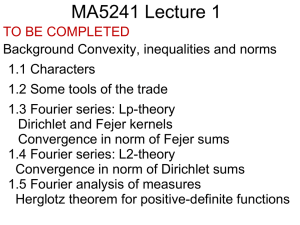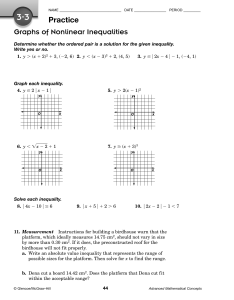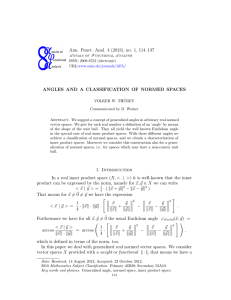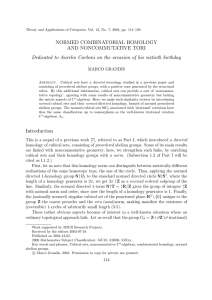Elementary Functional Analysis Notes for “Week 1” By Robert G
advertisement
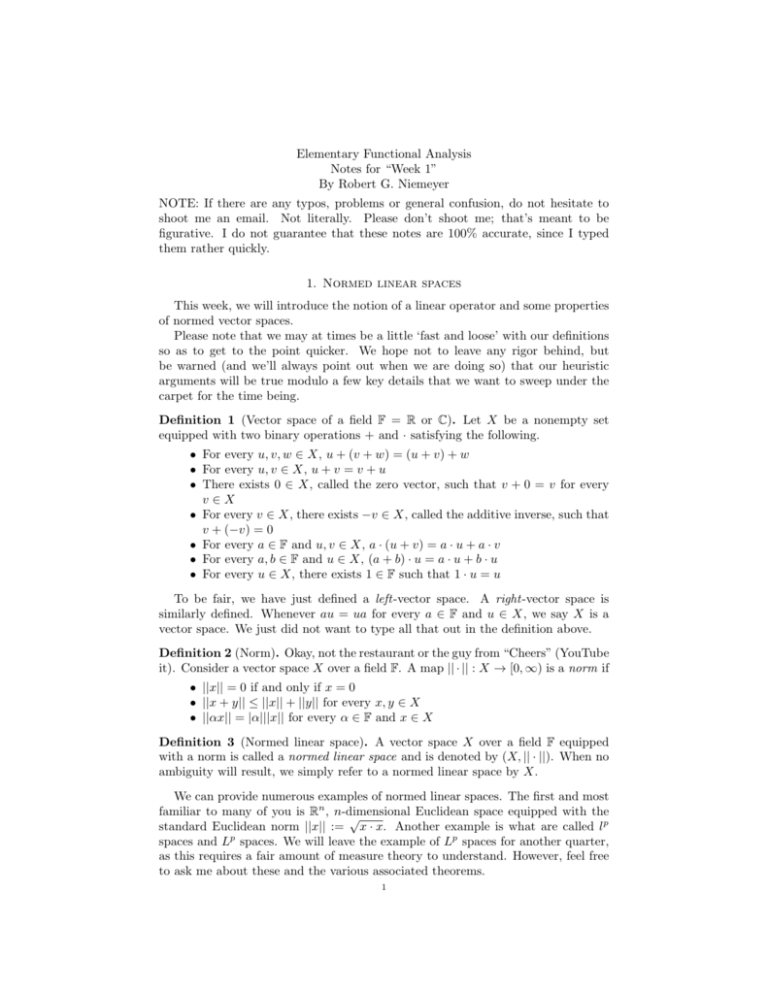
Elementary Functional Analysis
Notes for “Week 1”
By Robert G. Niemeyer
NOTE: If there are any typos, problems or general confusion, do not hesitate to
shoot me an email. Not literally. Please don’t shoot me; that’s meant to be
figurative. I do not guarantee that these notes are 100% accurate, since I typed
them rather quickly.
1. Normed linear spaces
This week, we will introduce the notion of a linear operator and some properties
of normed vector spaces.
Please note that we may at times be a little ‘fast and loose’ with our definitions
so as to get to the point quicker. We hope not to leave any rigor behind, but
be warned (and we’ll always point out when we are doing so) that our heuristic
arguments will be true modulo a few key details that we want to sweep under the
carpet for the time being.
Definition 1 (Vector space of a field F = R or C). Let X be a nonempty set
equipped with two binary operations + and · satisfying the following.
• For every u, v, w ∈ X, u + (v + w) = (u + v) + w
• For every u, v ∈ X, u + v = v + u
• There exists 0 ∈ X, called the zero vector, such that v + 0 = v for every
v∈X
• For every v ∈ X, there exists −v ∈ X, called the additive inverse, such that
v + (−v) = 0
• For every a ∈ F and u, v ∈ X, a · (u + v) = a · u + a · v
• For every a, b ∈ F and u ∈ X, (a + b) · u = a · u + b · u
• For every u ∈ X, there exists 1 ∈ F such that 1 · u = u
To be fair, we have just defined a left-vector space. A right-vector space is
similarly defined. Whenever au = ua for every a ∈ F and u ∈ X, we say X is a
vector space. We just did not want to type all that out in the definition above.
Definition 2 (Norm). Okay, not the restaurant or the guy from “Cheers” (YouTube
it). Consider a vector space X over a field F. A map || · || : X → [0, ∞) is a norm if
• ||x|| = 0 if and only if x = 0
• ||x + y|| ≤ ||x|| + ||y|| for every x, y ∈ X
• ||αx|| = |α|||x|| for every α ∈ F and x ∈ X
Definition 3 (Normed linear space). A vector space X over a field F equipped
with a norm is called a normed linear space and is denoted by (X, || · ||). When no
ambiguity will result, we simply refer to a normed linear space by X.
We can provide numerous examples of normed linear spaces. The first and most
familiar to many of you is Rn , n-dimensional
Euclidean space equipped with the
√
standard Euclidean norm ||x|| := x · x. Another example is what are called lp
spaces and Lp spaces. We will leave the example of Lp spaces for another quarter,
as this requires a fair amount of measure theory to understand. However, feel free
to ask me about these and the various associated theorems.
1
2
Example 1 (lp spaces). Let
lp denote the set of all sequences {xn }∞
n=1
P∞p ≥ 1. Let
p
of real numbers for which n=1 |xn | < ∞. We can define a norm as follows:
!1/p
∞
X
(1)
|xn |p
.
||{xn }∞
n=1 ||p :=
n=1
We must verify that || · || is indeed a norm. So, what do we do? We go back to the
definition.
Is lp a linear space? What is the zero vector? Verify the properties of a vector
space for your own personal edification. Is it true that ||{xn }|| = 0 if and only
if xn = 0 for every n ≥ 1? Suppose ||{xn }|| = 0. Then, since |xn |p is always
nonnegative, it follows that |xn | = 0 for every n ≥ 0. Or, xn = 0 for every n ≥ 0.
The converse it clear. The triangle inequality is a bit tricky (and in the case of
p > 1, such an inequality is referred to as the Minkowski inequality). What must
we do? We must verify that
(2)
||{xn } + {yn }||p ≤ ||{xn }||p + ||{yn }||p .
We know that ||{xn } + {yn }||p = ||{xn + yn }||p . You will need a number of facts
to prove the triangle inequality for the lp norm. So how about a digression.
1.1. Necessary facts to prove Minkowski’s inequality. We will need to understand what it means to be a convex function. Then two inequalities—Young’s
inequality and Hölders inequality—will aid us in proving the triangle inequality
holds for the lp -norm (which is better known as Minkowski’s inequality in this
context).
Recall that a space is convex if any two points in the space can be connected
by a line segment that is entirely contained in the space. A convex function is
something slightly different. However, line segments do come in to play.
Definition 4 (Convex function). Let X be a vector space. A real valued function
f : X → R is called convex if for any two points x, y ∈ X, f (tx + (1 − t)y) ≤
tf (x) + (1 − t)f (y), for every t ∈ [0, 1].
Theorem 1 (Young’s inequality). Suppose 1 < p < ∞ and q is conjugate to p.
Then, for every r, s ≥ 0, the following holds:
(3)
rs ≤
rp
sq
+ .
p
q
Sketch of the proof. Let t > 0, 0 < α < 1 and consider the convex function f (t) =
tα −αt (exercise: verify that f (t) is convex). We can show that f attains a maximum
at t = 1. Then, for every t > 0,
(4)
tα − αt ≤ 1 − α.
Substituting u/v for t, u, v ≥ 0 and v 6= 0 (recall the inequality is trivial is r or s
are zero), we have that
(5)
uα v 1−α ≤ αu + v(1 − α).
Substituting rp for u, sq for v and α = p−1 , the result follows (recall q is conjugate
to p).
3
Theorem 2 (Hölders inequality for sequences and series). If {xn }, {yn } ∈ lp and
q is such that 1/q = 1 − 1/p (i.e., q is conjugate to p), then
!1/p ∞
!1/q
∞
∞
X
X
X
p
(6)
|xn yn | ≤
.
|xn |
|yk |
n=1
n=1
n=1
This proof of this can be found in various texts (e.g., see [Meg, Appendix C]).
We will not prove it here, since we want to get on with verifying that || · ||p is a
norm. So, let us do that now.
Proof of Minkowski’s inequality, 1 < p < ∞. Suppose 1 < p < ∞ (the case when
p = 1, ∞ is left to the reader). Let q be conjugate to p and assume that ||(aj )||p
and ||(bj )||q are both nonzero and finite. Then,
X
X
(7)
|aj + bj |p ≤
(|aj | + |bj |)p
j
j
(8)
Fill in the missing line as an exercise
X
≤ 2p
max{|aj |p , |bj |p }
(9)
j
p
≤2 (
(10)
X
j
|aj |p +
X
|bj |p ).
j
The finiteness of ||(aj )||p and ||(bj )||q implies that the norm ||(aj + bj )||p is finite.
This is important in what follows (basically, we want to make sure we are not
dividing by infinity. That would be bad. Very bad). Now,
X
||(aj ) + (bj )||pp =
(11)
|aj + bj ||aj + bj |p−1
j
≤
(12)
X
|aj ||aj + bj |p−1 +
j
X
|bj ||aj + bj |p−1 .
j
Applying Hölders inequality to the sequences (|aj |) and (|aj + bj |p−1 ), we see that
(after a little work that we leave to the reader),
X
(13)
|aj ||aj + bj |p−1 ≤ ||(aj )||p ||(aj ) + (bj )||p−1
.
p
j
Similarly, applying Hölders inequality to the sequences (|bj |) and (|aj + bj |p−1 ), we
see that (after a little work that we again leave to the reader),
X
(14)
|bj ||aj + bj |p−1 ≤ ||(bj )||p ||(aj ) + (bj )||p−1
.
p
j
Therefore,
(15)
||(aj ) + (bj )||pp ≤ (||(aj )||p + ||(bj )||p )||(aj ) + (bj )||p−1
.
p
Dividing both sides by ||(aj ) + (bj )||pp−1 (and this is where it was important that
such a quantity by finite and non-zero), the result follows.
References
[Mac]
[Meg]
MacCluer, B. D.: “Elementary Functional Analysis”, Springer-Verlag, New York, 2009.
Megginson, R. E.: “An Introduction to Banach Space Theory”, Springer-Verlag, New
York, 1998.





